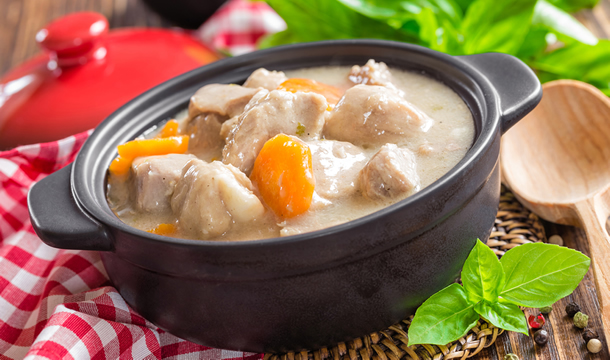From Maine to California, chicken and dumplings has found its way onto the menus of roadside diners and urban bistros, as well as those of edgy white-cloth restaurants offering haute interpretations of this old standby. Some argue that chicken and dumplings is the ultimate comfort food. Yet, every dish is as personal and unique as a fingerprint, having as many variations as chili or gumbo.

When you take a look around the world, you’ll find numerous dishes based on the simple formula of broth and dumplings in the same bowl. Tuscan tortellini or ravioli soup are kissing cousins to Asian wonton soup and Jewish kreplach. The popular Mexican breakfast dish of chilaquiles combines pulled chicken with tortilla wedges plumped to pillow-like texture in a seasoned broth.
Where It All Began
Like so many classic dishes, chicken and dumplings has its origins in frugality. As we know it today, chicken and dumplings is a product of the Great Depression, when stews and soups of meat and a starchy compliment helped stretch meager food supplies.
The differences in preparations range in results from a relatively thin soup consistency to a thickened, gravy-like texture that is suited to eating with a fork.
Another distinguishing variant is how the dumplings are made. Starting with biscuit dough, the variations include rolling the dough into walnut-sized nuggets, rolling the dough flat and cutting into squares or strips, and finally, the free-form dropped dumpling.
How It Works
The process goes like this:
- Boil a whole chicken or just chicken legs or thighs. Use enough water to cover and cook until the chicken is tender. If you want a richer broth, use chicken stock—low-sodium, homemade preferred—instead of water.
- When the chicken is cooked, remove it, let it cool, then shred it.
- While the enriched broth is still hot, add the dumplings and cook for 10 to 20 minutes, depending on the type. Dropped dumplings will take the least amount of time, while balls will take the most to cook through.
- When the dumplings are almost done, add the shredded chicken to the pot. Simmer another 10 to 15 minutes to reheat the chicken through and then you are ready to serve.
Veggies or Not
And while chicken, dumplings, and broth is a traditional way to serve, the addition of such herbs as thyme or sage and the inclusion of aromatic mirepoix vegetables (onion, celery, and carrot), mushrooms, peas, or peppers make it your own distinctive rendering of this culinary classic.
And what starts out as chicken and dumplings can just as easily be turned into pot pie with a two-layer crust instead of the dumplings.
Here’s Martha Stewart’s take on Chicken and Dumplings. Her version is distinguished by the addition of vegetables (onion, carrot, and peas) and dropped dumplings.
How thick do you like your chicken and dumplings? Would you prefer to eat it with a soup spoon or a fork? Do you prefer vegetables in the mix? What makes your chicken and dumplings like no one else’s?



Leave Your Response